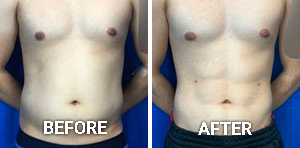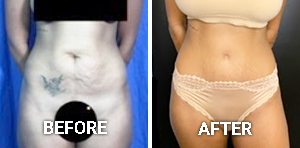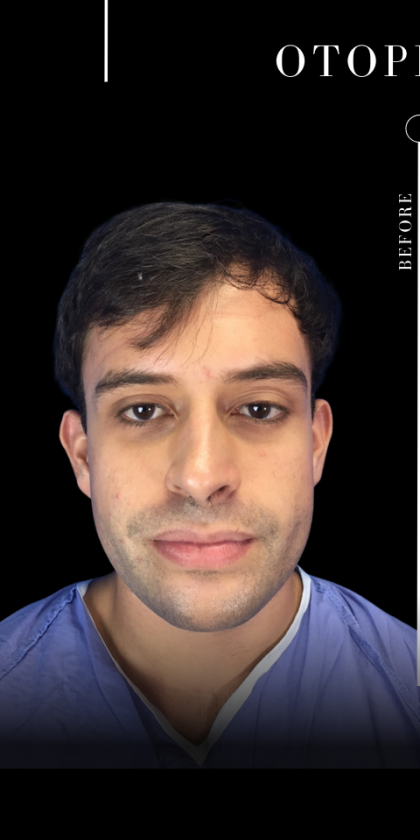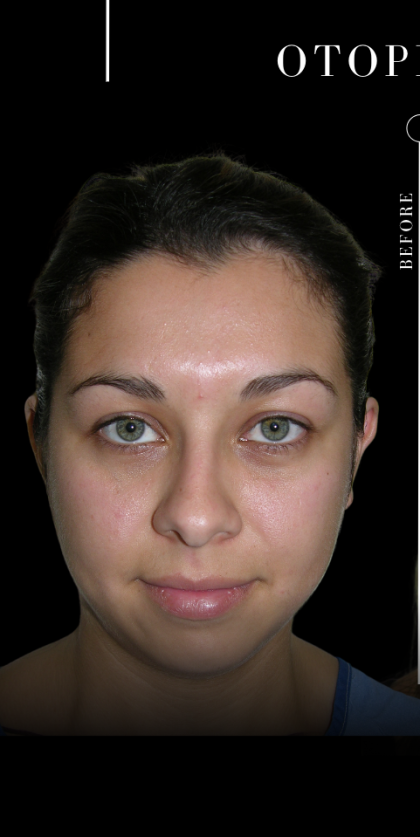Otoplasty
Conveniently located to serve the areas of Beverly Hills and Greater Los Angeles

An otoplasty is a cosmetic ear surgery that improves the shape and positioning of the ears. Surgeons can tailor their techniques to correct a variety of issues, but the most common otoplasty procedure involves the correction of prominent ears that protrude too far from the side of the head. Other prospective patients may seek to resolve overly large ears, asymmetries between the ears, or other congenital deformities. With precise suturing and cartilage modifications, surgeons can create permanent results that leave patients feeling more comfortable with their appearance. One of the most notable benefits of otoplasty is that it is safe for children, making it an excellent choice for helping them grow up without feelings of self-consciousness about their ears.
If you or your child are interested in the life-changing benefits of otoplasty, consider discussing your interest in the procedure with Dr. Michael Omidi, M.D., F.A.C.S., or Dr. Malcolm D. Paul, M.D., F.A.C.S., experienced, board-certified surgeons who take pride in delivering exceptional results and upholding their unique care philosophy.
To find out more about the consultation process, contact our office using our online form or give our team a call at (310) 281-0155. We can help you schedule your appointment at your earliest convenience and get you on your way to attaining the incredible results otoplasty can offer.
Contents
Before and After Photos
About Otoplasty
Otoplasty is a relatively rare procedure, but it is transformative for individuals who need it. The American Society of Plastic Surgeons cited that surgeons conducted approximately 53,000 of these surgeries for men, women, and children in 2020. (1) Not all surgeons have advanced knowledge of the intricate contours of the outer ear, but Dr. Omidi and Dr. Paul are highly trained in this type of reconstruction.
The procedure is suitable for children since the ears have already completed about 52% to 72% of their development at birth and finish maturing during childhood. (2) Because of this, our surgeons can typically perform otoplasty as early as age 5 or 6, helping prevent future peer bullying and ridicule over their ear appearance. Those with prominent ears usually develop them due to a dominant genetic trait that runs in the family, but they can also develop due to a congenital abnormality. It is often present in both ears, but sometimes, the harmless condition may only be present in one ear. Regardless of the nature of the condition, our surgeons can create a highly symmetrical outcome with no obvious signs of surgical intervention or scarring.
What Are Prominent Ears?
Prominent ears are easy to distinguish since they “stick out” from the skull in a more forward-facing way. There are also significant structural differences in these types of ears. In a normally developed outer ear, the antihelix (upper portion) exhibits a y-shaped fold to separate the tissue into the superior and inferior crus. In prominent ears, this upper portion is completely or partially flattened and creates a smoothened look. Since the positioning of the ears is also different, the ear lobe may also be angled forward. In certain types of prominent ears, the concha (opening of the ears) may appear deeper and more widened. They tend to be larger, exhibiting more surface area than normally developed ears. (3) Otoplasty can resolve all of the above-mentioned problems by reducing the concha and/or fixing the angle at which the ears sit. Surgeons can also recreate a normal-looking antihelix.
Otoplasty Candidates
Candidates must be at least 5 years of age and in overall good health without any conditions that affect blood-clotting or other wound-healing processes. Adult patients should be non-smokers or able to quit for a few weeks to promote more optimal blood circulation, allowing their bodies to recover faster from surgery. Finally, patients should also have realistic expectations and not expect to have perfect symmetry.
Personal Consultation
During your consultation, your surgeon will speak with you about the changes you would like to see after your otoplasty procedure, and they will closely evaluate your outer ear structures. They will give you a comprehensive treatment plan that includes their recommended surgical approaches for resolving your unique issues. They may go over what you need to do to prepare, the recovery you can expect, the extent of your procedure, and other factors required to create your final outcome. If you have any questions about otoplasty, we encourage you to come prepared for your consultation, and your surgeon will provide you with in-depth answers and related information.
To take your first step toward improved facial harmony with minimally invasive methods, get in touch with us using our contact form or call our Beverly Hills office at (310) 281-0155, and a team member will assist you with your inquiry.
Otoplasty Procedure Steps
Our surgeons perform otoplasty slightly differently depending on the age of the patient; children will require general anesthesia, but adults can undergo it with just local anesthesia and sedation. The method of anesthesia also depends on the complexity of the surgery. In general, surgeons complete the procedure in two steps: reshaping and/or resizing the outer ear and positioning it closer to the head. Every ear is different and requires a particular approach that aligns with the patient’s cosmetic goals. These changes typically involve these aspects:
- An incision behind or within the ear to keep postoperative scarring to a minimum
- Removal of cartilage and skin to reduce overall size and/or the concha
- Cartilage folding and the application of sutures to hold it in place permanently
Surgeons complete the procedure in just 2 to 3 hours, then apply the appropriate bandages to protect the incisions and keep all internal adjustments in place.
Incisionless Otoplasty
For the right candidates, our surgeons can perform an “incisionless” otoplasty, a common type of ear pinning surgery. With this method, they will administer local anesthesia into the ear, loosen the cartilage with a needle, and then apply sutures to correct prominent ears without needing to make an incision along the back of the outer ear. The recovery from this procedure is similar to a standard otoplasty.
Recovery and Results
After your procedure, your surgeon will monitor you and discharge you to go home on the same day. You will experience some swelling and bruising in the days following, but you can mitigate these effects with doctor-approved OTC medications that do not have blood-thinning qualities. After about 4 or 5 days, you will have to return to our office, and your surgeon will remove the postsurgical bandaging and check your healing progress. After this appointment, you will be able to go back to work and resume most daily activities.
In the second stage of your recovery, you will have to wear an elastic headband to continue to protect your ears at night. You will likely have to wear this band for at least 4 weeks to give the cartilage adequate time to heal; these tissues tend to heal slower than more vascularized areas. After about 10 days, your surgeon will take out the external sutures and reevaluate your ears. At this point in your recovery, all bruising should be gone, but you will have to wait at least 2 to 3 weeks to see the results without any residual swelling. Sometimes, it takes a few extra weeks for the ears to settle and “relax” into their final placement.
You will have to refrain from physically strenuous workouts for at least 1 to 2 months; your surgeon will let you know when it is safe to return to the gym. If your child is the one to undergo the procedure, please keep in mind that you will have to monitor them closely to make sure they do not touch or place pressure on their ears.
Cost of Otoplasty in Beverly Hills

The cost of your ear surgery will depend on the techniques utilized, your anesthesia fees, any post-surgical medications, follow-up appointments, and other fees to promote an optimal outcome. Dr. Omidi or Dr. Paul will give you a comprehensive breakdown of the costs involved during your consultation with them, helping you decide if the otoplasty is right for you. If interested, you can explore financing options, allowing you to make affordable payments over a period of time.
If you are ready to feel like your most confident self with improved ear contours, contact us for a consultation by calling (310) 281-0155 or filling out our online form. We will get back to you as soon as possible. If you want to learn more about our other procedures and skin rejuvenation treatments, visit our blog.
FAQ
Will I have visible scars after otoplasty?
The incisions made during otoplasty are strategically placed behind or within natural creases to minimize any visible scarring. Over time, the scars will fade and become less noticeable.
Does an otoplasty create permanent results?
Yes, the adjustments made during an otoplasty will create permanent results once the cartilage fully heals a few weeks post-surgery. It usually takes 2 to 3 weeks for swelling to fully subside.
Is there a non-surgical alternative to otoplasty?
Ear splinting involves applying an outer ear splint to encourage the ears to grow closer to the skull, but this non-invasive method is only effective for babies. Only an otoplasty can create lasting results for children and adults. A less invasive form of surgery is an “incisionless” approach that involves applying permanent sutures to the cartilage through the skin, without needing to make an incision.
Will I have scarring after an otoplasty?
Any scars after an otoplasty are hidden behind the outer ear, so they are discreet.
References
- American Society of Plastic Surgeons. Plastic Surgery Statistics Report.; 2020. https://www.plasticsurgery.org/documents/News/Statistics/2020/plastic-surgery-statistics-report-2020.pdf
- Purkait R. Progression of Growth in the External Ear from Birth to Maturity: A 2-Year Follow-Up Study in India. Aesthetic Plastic Surgery. 2013;37(3):605-616. doi:https://doi.org/10.1007/s00266-013-0097-1
- Driessen JP, Johannes Borgstein, Vuyk HD. Defining the Protruding Ear. Journal of Craniofacial Surgery. 2011;22(6):2102-2108. doi:https://doi.org/10.1097/scs.0b013e3182326dfb









